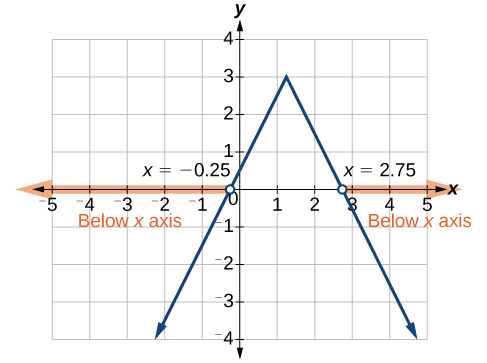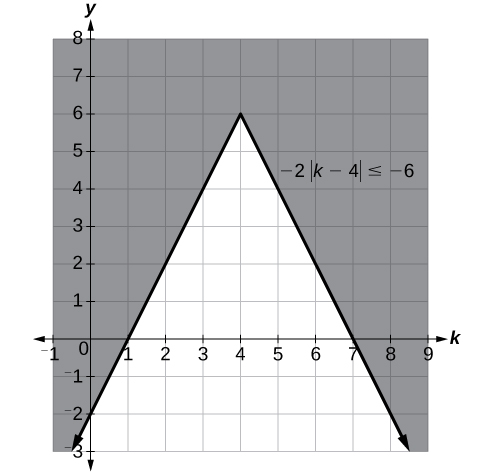Compound and Absolute Value Inequalities
Learning Objectives
- Solve compound inequalities
- Solve absolute value inequalities
Example: Solving a Compound Inequality
Solve the compound inequality: [latex]3\le 2x+2<6[/latex].Answer: The first method is to write two separate inequalities: [latex]3\le 2x+2[/latex] and [latex]2x+2<6[/latex]. We solve them independently.
Try It
Solve the compound inequality [latex]4<2x - 8\le 10[/latex].Answer: [latex]6<x\le 9\text{ }\text{ }\text{or}\left(6,9\right][/latex]
Solving Absolute Value Inequalities
As we know, the absolute value of a quantity is a positive number or zero. From the origin, a point located at [latex]\left(-x,0\right)[/latex] has an absolute value of [latex]x[/latex], as it is x units away. Consider absolute value as the distance from one point to another point. Regardless of direction, positive or negative, the distance between the two points is represented as a positive number or zero. An absolute value inequality is an equation of the formA General Note: Absolute Value Inequalities
For an algebraic expression X, and [latex]k>0[/latex], an absolute value inequality is an inequality of the formExample: Determining a Number within a Prescribed Distance
Describe all values [latex]x[/latex] within a distance of 4 from the number 5.Answer:
We want the distance between [latex]x[/latex] and 5 to be less than or equal to 4. We can draw a number line to represent the condition to be satisfied.
 The distance from [latex]x[/latex] to 5 can be represented using an absolute value symbol, [latex]|x - 5|[/latex]. Write the values of [latex]x[/latex] that satisfy the condition as an absolute value inequality.
The distance from [latex]x[/latex] to 5 can be represented using an absolute value symbol, [latex]|x - 5|[/latex]. Write the values of [latex]x[/latex] that satisfy the condition as an absolute value inequality.
Try It
Describe all x-values within a distance of 3 from the number 2.Answer: [latex]|x - 2|\le 3[/latex]
Example: Solving an Absolute Value Inequality
Solve [latex]|x - 1|\le 3[/latex].Answer:
Example: Using a Graphical Approach to Solve Absolute Value Inequalities
Given the equation [latex]y=-\frac{1}{2}|4x - 5|+3[/latex], determine the x-values for which the y-values are negative.Answer: We are trying to determine where [latex]y<0[/latex], which is when [latex]-\frac{1}{2}|4x - 5|+3<0[/latex]. We begin by isolating the absolute value.

Try It
Solve [latex]-2|k - 4|\le -6[/latex].Answer:
[latex]k\le 1[/latex] or [latex]k\ge 7[/latex]; in interval notation, this would be [latex]\left(-\infty ,1\right]\cup \left[7,\infty \right)[/latex].

Try It
Sometimes a picture is worth a thousand words. You can turn a single variable inequality into a two variable inequality and make a graph. The x-intercepts of the graph will correspond with the solution to the inequality you can find by hand. Let's use the last example to try it, we will change the variable to x to make it easier to enter in Desmos. To turn [latex]-2|x - 4|\le -6[/latex] into a two variable equation, move everything to one side, and place the variable y on the other side, like this:
[latex]-2|x - 4|\le -6[/latex] [latex]-2|x - 4|+6\le y[/latex]
Now enter this inequality in Desmos and hover over the x-intercepts.
![]() If you need instruction on how to enter inequalities in Desmos, watch this tutorial.
If you need instruction on how to enter inequalities in Desmos, watch this tutorial.
Now you try turning this single variable inequality into a two variable inequality:
[latex]5|9-2x|\ge10[/latex]
Graph your inequality with Desmos, and write the solution interval. [practice-area rows="2"][/practice-area]Licenses & Attributions
CC licensed content, Original
- Revision and Adaptation. Provided by: Lumen Learning License: CC BY: Attribution.
CC licensed content, Shared previously
- College Algebra. Provided by: OpenStax Authored by: Abramson, Jay et al.. License: CC BY: Attribution. License terms: Download for free at http://cnx.org/contents/[email protected].
- Learn Desmos: Inequalities. Authored by: Desmos. License: Public Domain: No Known Copyright.
- Question ID 92608, 92609. Authored by: Michael Jenck. License: CC BY: Attribution. License terms: IMathAS Community License, CC-BY + GPL.
- Question ID 89935. Authored by: Krystal Meier. License: CC BY: Attribution. License terms: IMathAS Community License CC-BY + GPL.
- Question ID 15505. Authored by: Tophe Anderson. License: CC BY: Attribution. License terms: IMathAS Community License CC- BY + GPL.
CC licensed content, Specific attribution
- College Algebra. Provided by: OpenStax Authored by: OpenStax College Algebra. Located at: https://cnx.org/contents/[email protected]:1/Preface. License: CC BY: Attribution.
